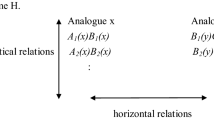Abstract
Visual analogy is believed to be important in human problem solving. Yet, there are few computational models of visual analogy. In this paper, we present a preliminary computational model of visual analogy in problem solving. The model is instantiated in a computer program, called Galatea, which uses a language for representing and transferring visual information called Privlan. We describe how the computational model can account for a small slice of a cognitive-historical analysis of Maxwell’s reasoning about electromagnetism.
Similar content being viewed by others
References
Bhatta, S.R. and A.K. Goel: 1997a, A Functional Theory of Design Patterns. In Proceedings of the International Joint Conference for Artificial Intelligence, 294–300.
S. Bhattta A.K. Goel (1997b) ArticleTitleLearning Generic Mechanisms for Innovative Design Adaptation Journal of Learning Sciences 6 IssueID4 367–394
M. Boden (1990) The Creative Mind: Myths and Mechanisms Basic Books London
B. Chandrasekaran A. Goel Y. Iwasaki (1993) ArticleTitleFunctional Representation as a Basis for Design Rationale IEEE Computer 26 IssueID1 48–56
Clement, J.: 1994a, Imagistic Simulation and Physical Intuition in Expert Problem Solving. Proceedings of the 16th Annual Conference of the Cognitive Science Society. Hillsdale, NJ: Lawrence Erlbaum, 201–206.
J. Clement (1994b) Use of Physical Intuition and Imagistic Simulation in Expert Problem Solving D. Tirosh (Eds) Implicit and Explicit Knowledge Ablex Publishing Corp Norwood, NJ
D. Croft P. Thagard (2002) Dynamic Imagery: A Computational Model of Motion and Visual Analogy L. Magnani (Eds) Model-based Reasoning Scientific Discovery, Technological Innovation, Values Kluwer/Plenum New York
Davies, J. and A.K. Goel: 2001, Visual Analogy in Problem Solving. In Proceedings of the International Joint Conference on Artificial Intelligence.
K. Duncker (1926) ArticleTitleA Qualitative (Experimental and Theoretical) Study of Productive Thinking (Solving of Comprehensible Problems) Journal of Genetic Psychology 33 642–708
Do, E.Y. and M.D. Gross: 1995a, Drawing Analogies: Supporting Creative Architectural Design with Visual References. In E. Do, M.D. Gross and J. Gero (eds.), 3rd International Conference on Computational Model of Creative Design (HI ’95). Australia, 37–58.
Do, E.Y. and M.D. Gross: 1995b, Drawing Analogies: Finding Visual References by Sketching. In L. Kalisperis and B. Kolarevic (eds.), Proceedings of the Association for Computer Aided Design in Architecture (ACADIA95), 1995 National Conference for Computing in Design. Seattle, 35–52.
B. Falkenhainer K.D. Forbus D. Gentner (1990) ArticleTitleThe Structure Mapping Engine: Algorithm and Examples Artificial Intelligence 41 1–63
Ferguson, R. and K.D. Forbus: 2000, GeoRep: A flexible tool for Spatial Representation of Line Drawings. In Proceedings of the 17th National Conference on Artificial Intelligence. Cambridge, MA: AAAI Press/MIT Press, 510–516.
J. Glasgow D. Papadias (1998) Computational Imagery P. Thagard (Eds) Mind Readings MIT Press Cambridge, MA 157–205
Goel, A.K.: 1991a, Model Revision: A Theory of Incremental Model Learning. In Proceedings of the 8th International Conference on Machine Learning (ICML91), Chicago, June 1991. Los Altos, CA: Morgan Kaufmann, 605–609.
Goel, A.K.: 1991b, A Model-Based Approach to Case Adaptation. In Proceedings of the 13th Annual Conference of the Cognitive Science Society, Chicago, August 1991. Hillsdale, NJ: Lawrence Erlbau, 143–148.
A. Goel S. Bhattta E. Stroulia (1997) Kritik: An Early Case-Based Design System M.L. Maher P. Perl (Eds) Issues and Applications of Case-Based Design Erlbaum Hillsdale, NJ 87–132
G. Goldschmidt (1995) Visual Displays for Design: Imagery, Analogy and Databases of Visual Images A. Koutamanis H. Timmermans I. Vermeulen (Eds) Visual Databases in Architecture: Recent Advances in Design and Decision Making Brookfield Avebury 53–76
D.C. Gooding (1994) Experiment and the Making of Meaning Kluwer Academic Publishers Dordrecht
Griffith, T.W., N.J. Nersessian and A. Goel: 1996, The Role of Generic Models in Conceptual Change. In Proceedings of the 19th Annual Conference of the Cognitive Science Society. San Diego, 312–317.
Griffith, T.W., N.J. Nersessian and A. Goel: 2000, Function-Follows-Form Transformations in Scientific Problem Solving. In Proceedings of the 22nd Annual Conference of the Cognitive Science Society. Mahwah, New Jersey: Lawrence Erlbaum Associates, 196–201.
K.J. Holyoak P. Thagard (1997) ArticleTitleThe Analogical Mind American Psychologist 52 IssueID1 35–44 Occurrence Handle10.1037/0003-066X.52.1.35
S.M. Kosslyn (1994) Image and Brain: The Resolution of the Imagery Debate MIT Press Cambridge, MA
Maxwell, J.C.: 1861–1862, On Physical Lines of Force. In D. Niven (ed.), The Scientific Papers of J.C. Maxwell. Cambridge: Cambridge University Press, 1890. Reprinted in 1952, New York: Dover Publications, Vol. 1, 451–513.
McGraw, G. and D.R. Hofstadter: 1993, Perception and Creation of Alphabetic Style. In Artificial Intelligence and Creativity: Papers from the 1993 Spring Symposium, AAAI Technical Report SS-93-01. AAAI Press.
Nersessian, N.J.: 1984, Faraday to Einstein: Constructing Meaning in Scientific Theories. Dordrecht: Kluwer, 68–93.
N.J. Nersessian (1992) How Do Scientists Think? Capturing the Dynamics of Conceptual Change in Science R.N. Giere (Eds) Cognitive Models of Science University of Minnesota Press Minneapolis MN 5–22
Nersessian, N.J. 1994a, Opening the Black Box: Cognitive Science and the History of Science. In A. Thackray (ed.), constructing knowledge in the history of science. Osiris, Vol. 10, 194–214.
Nersessian, N.J.: 1994b, Abstraction via Generic Modeling in Concept Formation in Science. Georgia Institute of Technology Cognitive Science Technical Report 94/22. To appear in M.R. Jones and N. Cartwright (eds.), Idealization and Abstraction in Science. Amsterdam: Editions Rodopi, in press.
N.J. Nersessian (2001) Maxwell and ‘the Method of Physical Analogy’: Model- Based Reasoning, Generic Abstraction, and Conceptual Change D. Malamet (Eds) Reading Philosophy of Nature: Essays in the History and Philosophy of Science and Mathematics to Honor Howard Stein on his 70th Birthday Open Court, in press LaSalle, IL
R. Pedone J.E. Hummel K.J. Holyoak (2001) ArticleTitleThe Use of Diagrams in Analogical Problem Solving Memory and Cognition 29 214–221
S. Prabhakar A. Goel (1996) ArticleTitleLearning about Novel Operating Environments: Designing by Adaptive Modelling, Artificial Intelligence in Engineering Design, Analysis and Manufacturing Special Issue on Machine Learning 10 136–142
Thagard, P., D. Gochfeld and S. Hardy: 1992, Visual Analogical Mapping. In Proceedings of the 14th Annual Conference of the Cognitive Science Society. Erlbaum: Hillsdale, 522–527.
Author information
Authors and Affiliations
Rights and permissions
About this article
Cite this article
Davies, J., Nersessian, N.J. & Goel, A.K. Visual Models in Analogical Problem Solving. Found Sci 10, 133–152 (2005). https://doi.org/10.1007/s10699-005-3009-2
Issue Date:
DOI: https://doi.org/10.1007/s10699-005-3009-2




